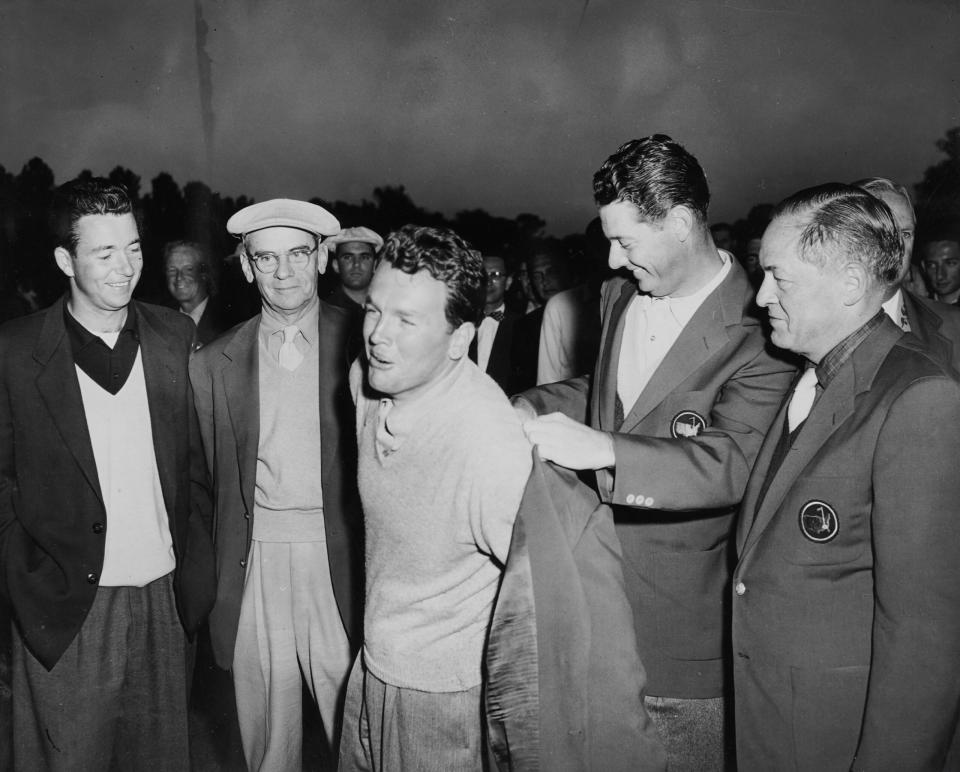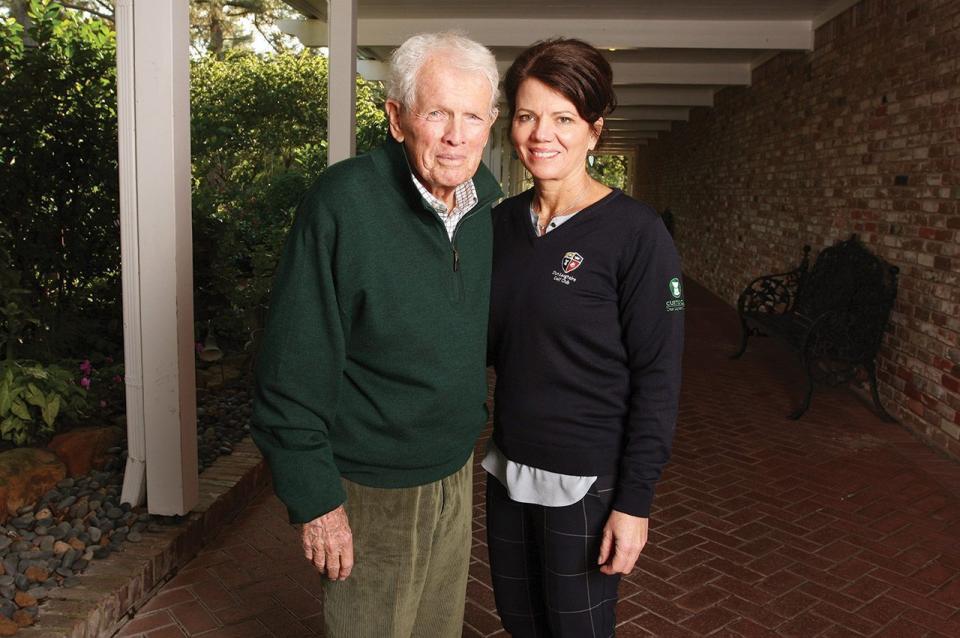Jack Burke Jr., who was the oldest living member of the World Golf Hall of Fame, has died at age 100

John “Jack” Joseph Burke Jr. won 17 times on the PGA Tour, including two majors in 1956 – the Masters and PGA Championship – earning him Player of the Year honors. In 1952, he won four tournaments in a row, along with the Vardon Trophy, which is awarded for low scoring average. He played on five Ryder Cup teams during the 1950s, captained twice and hosted another at his own course.
Burke died on Friday at the age of 100.
While still at the peak of his abilities, he retired from the Tour and built one of the country’s first golf-only clubs – Champions Golf Club in Houston – with his former childhood babysitter and closest friend, fellow World Golf Hall of Famer Jimmy Demaret.
Burke grew up on River Oaks Country Club in Texas during the Great Depression, where his father, Jack, served as the first club pro in the state’s history and mentored the likes of Ben Hogan, Byron Nelson, Jack Grout and Harvey Penick. Young Jackie suffered from asthma and couldn’t play other sports so at age 7 he began sitting and listening at the feet of his father, who is himself a member of the Texas Golf Hall of Fame.
By age 12, Burke Jr. could break par and a year later gave his first lesson to John P. Fusler, who paid him $350 when Burke helped lower his scores from 100 to 85.
“He thought I was the greatest teacher in the world, but all I was doing was relating what I had heard at the dinner table,” Burke told the USGA’s Golf Journal in 1995.
He landed a job as a teaching professional at Galveston Country Club in Houston before he turned 20, and would later hold jobs at Hollywood Golf Club in New Jersey and Metropolis Country Club in New York. One time, in the company of Demaret and his golf buddy Bob Hope, the comedian innocently asked Burke, “What do you do?”
“I’m a golf professional,” Burke answered.
“Where?” Hope asked. “At Boys Town?”
The finest hour as a player for “the pro from Boys Town,” as Burke was affectionately called, may have been the final round of the 1956 Masters, which is still widely considered to be the toughest conditions of cold, wind and rain in tournament history. Somehow, Burke held it together against the elements to shoot 71 and erase an eight-stroke deficit as amateur Ken Venturi ballooned to an 80.
“He handed me the trophy,” said Burke, overlooking the fact that he tied for the low round of the day to finish at 1-over 289, still tied for the highest winning score in tournament history. “I thank him a lot for that.”
Burke, who was paired in the final round with Mike Souchak, always was known for his stellar putting and his short stick was his sword and his shield at Augusta National as he relied on a short, tap putting stroke.
“Sand had blown out of the bunkers all over the green,” he told Golf Digest in 2002 of a critical birdie putt he holed at 17. “I’d putted on sand greens in east Texas that were really fast, and factored that in, but I still thought I’d hit it about halfway — till the wind blew it right in the center of the cup. Mike’s a cheerleader-type guy, and he ran to pick the ball out of the cup and then clapped me so hard on the back I had to walk around on the 18th tee to recover. I put my second shot on 18 in the right bunker and had to make a downhill four-footer to save my par. It still makes me almost ill to think about that putt with the outcome riding on it.”
Burke won the 1956 PGA Championship at Blue Hill Golf & Country Club in Canton, Massachusetts, just outside of Boston, back when it was contested at match play, defeating Ted Kroll, 3 and 2, in the final.
“I beat eight guys to win the PGA,” Burke recalled. “Each day you felt like you’re standing on the edge of a cliff and some guy was going to push you off. I never felt like I was going to win the PGA. Never.”
Indeed, Burke needed two extra holes to prevail over Fred Haas in the third round and was five down after 14 holes in the 36-hole semifinals before rallying to knock off Ed Furgol on the 37th hole. And for good measure, he trailed three down midway into the finals before edging Kroll.
At the time, the life of a Tour pro was a meager existence, even during a banner year. Many years later, Burke claimed that he received more for attending the Champions Dinner at the Masters than he did for winning it.
“I won the PGA in Boston and my check was hot,” Burke once told the Houston Chronicle. “I couldn’t cash my check for $6,000. The PGA had to guarantee my check.”
It led Burke to consider scaling back his tournament schedule to spend more time with his family. He and Demaret, a three-time winner of the Masters who died in 1983, shared a mutual interest in creating a haven for hardcore golfers that would capitalize on the knowledge and experience they’d gained from playing the game around the world.
“Golf is really in your blood when you drive through a strange area and start envisioning golf holes on every piece of property around the next bend,” Burke said in his autobiography, “It’s Only a Game.”
“This is what happened with Jimmy and me when we envisioned Champions. We looked at several pieces of property, but the land here looked just right for a golf course.”
They acquired 500 acres (at $500 per) in Northwest Houston in 1957, out in what was then a forest of pine and oak trees in the middle of nowhere, to build two courses – Cypress Creek and Jackrabbit – and hired Ralph Plummer as the architect.
On April 21, 1959, celebrities Bing Crosby, Mickey Mantle and James Garner joined Ben Hogan, Jay Hebert, Bob Rosburg and Souchak among the more than 6,000 who attended the grand opening. A day earlier, Burke and Julius Boros battled in an 18-hole playoff at the Houston Classic. Boros shot a 3-under-par 69 at Memorial Park…and lost by five.
“I believe we should have a saliva test on Jackie,” Boros said at the time. “As soon as he is available, I would like to sign up for a series of lessons.”
Burke’s reputation as “America’s grand golf sage” helped attract numerous prominent competitions to the club and tested golf’s elite amateurs and pros ever since. The Cypress Creek Course was home of the Tour Championship five times between 1990 and 2003, hosted tour events from 1966-’71 – Ben Hogan chose the course for his final tournament appearance of his career at the 1971 Houston Champions International – the 1967 Ryder Cup, 1969 U.S. Open, 1993 U.S. Amateur, 1998 and 2017 U.S. Women’s Mid-Amateur, and 2020 U.S. Women’s Open. Burke was one of five Champions members who have won the PGA Championship, along with Steve Elkington, Hal Sutton and the late Dave Marr and Jay Hebert. When a local sportscaster asked Burke if that’s unusual, he said, “Hell, we’ve got three members who walked on the moon,” referring to astronauts Alan Shepard, who hit a golf ball there, Gene Cernan and Charles Duke.

Jack and Robin Burke in 2016. (Golfweek/Tracy Wilcox)
Burke continued to foster the same atmosphere that his father promoted at River Oaks. Golf is it at Champions. In fact, he was so dedicated to protecting the spirit of competition that he refused to consider members who have a handicap higher than 15.
“You play your way in, you don’t buy your way in,” Burke once said.
Burke claimed that a country club where no one plays the game seriously “is like a yacht club where no one can sail a boat.”
Champions Club likely will be his most lasting legacy, which is just how Burke always wanted it.
“My dad said to me once, ‘Son, before you leave this planet, you try and leave more than two footprints here. So, I said, ‘I will do that,’ ” he said. “This is my footprint.”
Burke, who served in the Marines during World War II and fathered six children, was inducted into the World Golf Hall of Fame in 2000, and in 2004 received the Bob Jones Award from the U.S. Golf Association, which is considered its highest honor and awarded for distinguished sportsmanship.
Burke has tutored the likes of Crenshaw, Elkington, Sutton and Phil Mickelson. Crenshaw once described a lesson with Burke as “a full-contact sport,” and former touring pro turned Golf Channel commentator Billy Ray Brown is living proof of that. Brown, a former University of Houston star, missed a putt at the start of a lesson from Brown and received a whack alongside the head for it.
“Son,” Burke said, “I want you to feel pain when you miss a putt.”
When Mickelson made his first pilgrimage to Champions for a lesson from Burke, he was challenged to pass Burke’s putting-pressure test: holing 100 straight three-footers. In typical Mickelson fashion, he bet Burke dinner at Houston’s finest restaurant in town that he could do it on the first try. Mickelson missed his fourth putt and wanted to double down.
In recounting the story to Golf Digest, Burke said, “Man, I can’t eat that much.” During his heyday, Burke would make the 100 putts every night before allowing himself dinner. “You’d get to 89 and you were a little tired and hungry. The key is to strike a carpenter’s 90, with the blade square to the line, and concern yourself less with sinking putts. Losers are result-oriented — winners are execution-oriented. On long putts, your target is that three-foot cup. You need mental aids.”
“Being with him was like a tonic for the soul,” Crenshaw said.
Sutton, who made Burke one of his assistant captains to the 2004 U.S. Ryder Cup team, said the smartest decision he made as a young pro was buying a house next door to Burke, who he considered one of the few people who really understood the game in its entirety.
“He’s seen all the great players, he knows how they hit it. He understands the golf swing, he’s made it happen and he’s been a great player in his own day,” said Sutton, who looked at Burke as a spiritual advisor, sports psychologist, sounding board, confidante, cheerleader and surrogate parent. “Without even knowing it, he did a great deal to make me a better, more well-rounded person.”

 Yahoo Sports
Yahoo Sports 
